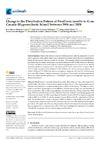Identificador persistente para citar o vincular este elemento:
https://accedacris.ulpgc.es/jspui/handle/10553/132127
| Título: | Change in the Distribution Pattern of Dirofilaria immitis in Gran Canaria (Hyperendemic Island) between 1994 and 2020 | Autores/as: | Montoya Alonso, José Alberto García Rodríguez, Sara Nieves Matos Rivero, Jorge Isidoro Costa Rodríguez, Noelia Falcon Cordón, Yaiza Carretón, Elena Morchon García, Rodrigo |
Clasificación UNESCO: | 240112 Parasitología animal | Palabras clave: | Dirofilaria immitis Heartworm disease Zoonosis Vector-borne Prevalence, et al. |
Fecha de publicación: | 2024 | Publicación seriada: | Animals | Resumen: | Dirofilariosis is a zoonotic disease that mainly affects dogs and cats, with a high risk to public health. The island of Gran Canaria (Spain) has been shown to be a hyperendemic area of infection and, therefore, a model for studying the evolution of the disease. The objective of this study was to track the prevalence and distribution of heartworm in dogs, cats, and residents of Gran Canaria from 1994 to 2020, using published and unpublished data. Blood samples from 5841 dogs, 1203 cats, and 1604 humans were collected in the years analyzed, considering geographical and isoclimatic factors. In 1994, a prevalence of Dirofilaria immitis of 67.02% in dogs was reported, while in 2020 it was 15.81%. In cats, the seroprevalence in 2010 was 33.03%, compared to 17.20% in 2020. The incidence of D. immitis in humans in 2008 was 18.66%, while in 2020 it was 8.27%. For all study groups, temperate cold zone (TC) and temperate mild zone (TM) climates had the highest prevalence. Throughout these 20 years, the prevalence of heartworm disease has decreased. Despite this, it continues to be a hyperendemic island. This study highlights the importance of using the “One Health” perspective and the risks of contagion of the disease. | URI: | https://accedacris.ulpgc.es/handle/10553/132127 | ISSN: | 2076-2615 | DOI: | 10.3390/ ani14142037 | Fuente: | Animals [ISSN 2076-2615], 14 (4), 2034 (Julio 2024) |
| Colección: | Artículos |
Citas SCOPUSTM
5
actualizado el 08-jun-2025
Visitas
180
actualizado el 05-jul-2025
Descargas
56
actualizado el 05-jul-2025
Google ScholarTM
Verifica
Altmetric
Comparte
Exporta metadatos
Los elementos en ULPGC accedaCRIS están protegidos por derechos de autor con todos los derechos reservados, a menos que se indique lo contrario.
